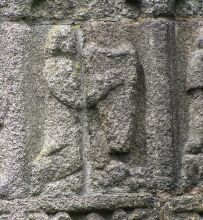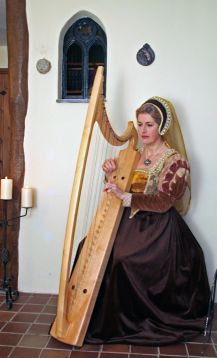The History of the
harp in England
From the Dark Ages to the
Victorians:-
 |
"And in his
harping, when he had songe,
his eyen twinkeled
in his head aright,
as don the starres
in the frosty night."
Chaucer's Friar
Left,
The shadowy external outline of a harper, parish church,
Launceston, Cornwall, 16thC.
Right,
Sarah with her reproduction English medieval harp at
Muchelney Abbey.
|
 |
The history of the
harp has been written about many times in the past, but often
from an exclusively 'Celtic' viewpoint - so much so that the vast
majority of people nowadays believe the harp to be an exclusively
'Celtic' instrument. But through years of her own research Sarah
Deere-Jones, who now lectures on this subject around the world,
has revealed that the small harp has been in England since the
10th century and by the 14th century had become the National
Instrument of England, played and loved by medieval Kings, their
wives, their court musicians aswell as common minstrels across
the country.
Sarah is intending
to publish articles on this subject in the near future, she has a
collection of her own images taken from her travels around the UK
- if you know of any medieval images, paintings or sculptures of
English harpers, and know the dates and sources, please email us
as this research is ongoing and your conrtibution will be
gratefully received!
Cornish
Nationalists please note - I include Cornwall under the term
'English' purely because I do not wish to exclude Cornish
references from my main research, and because Cornish examples
ARE excluded, somewhat ironically, from research by other
'Celtic' harp historians. The harp in Cornwall did not appear to
be any different either in form or use to the harp in England
during the medieval period, and therefore it is included here. My
option would be to exclude references to the harp in Cornwall
altogether, which I feel would be a shame, since it is not
included elsewhere. There is not very much information about
medieval harps in Cornwall and therefore it was not worth
treating as a separate subject, no offence is intended.
Right,
illustration from Junious II in the Bodleian Library, and
dated from 930ad,
the oldest
depiction of a triangular closed frame harp from England.
St Dunstan,
who was Archbishop of Canterbury in the 10th century,
is believed
to be one of the first English harpers,
he is
reputed to have soothed King Athelstan with his harp
playing at his court in Winchester,
when the
King was 'fatigued with worldy cares' -
perhaps
indeed St Dunstan was the very first 'healing harpist'!
|
 |
Sarah
Deere-Jones and Phil Williams play reproduction medieval
instruments in 'Lammas' medieval duo here- https://www.youtube.com/watch?v=snN0EApT-Z8
info (at) cornwallharpcentre.co.uk
Home | Courses &
Tuition | Sarah Deere-Jones | Sheet Music and CDs | Ensemble | History |Regency Harp and
Harp-Lute




